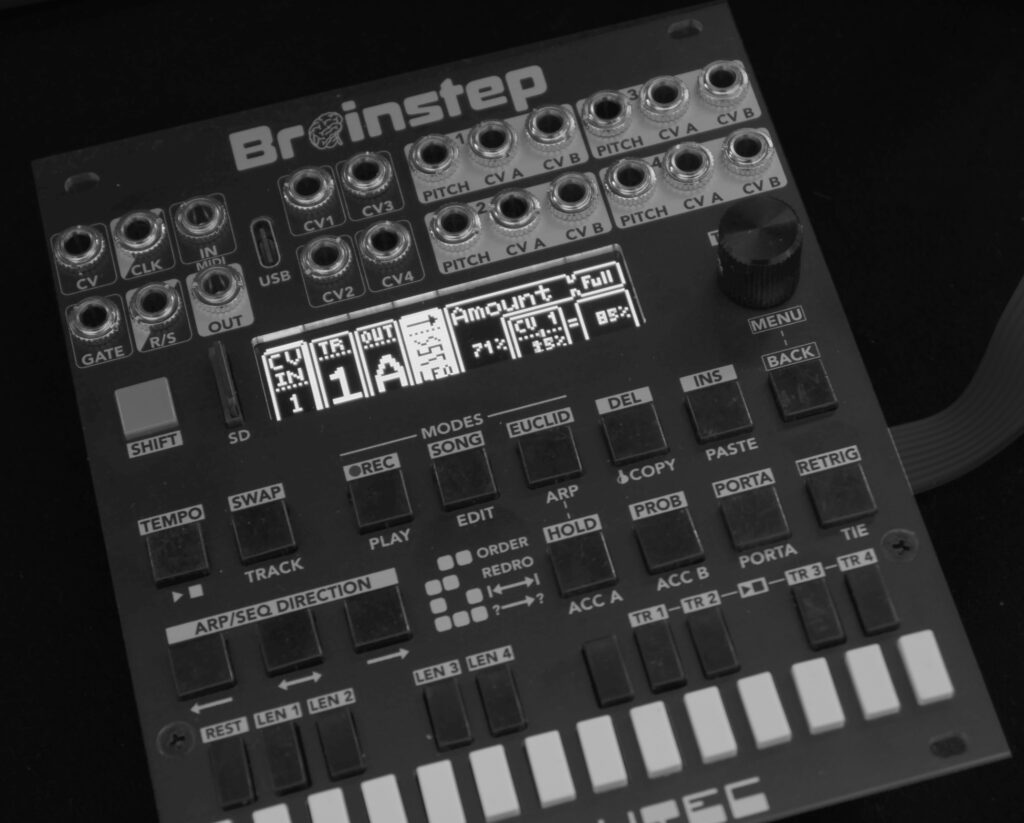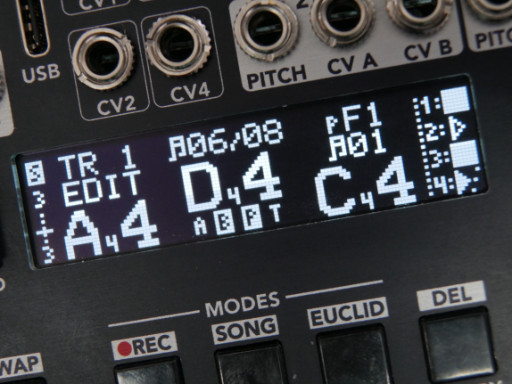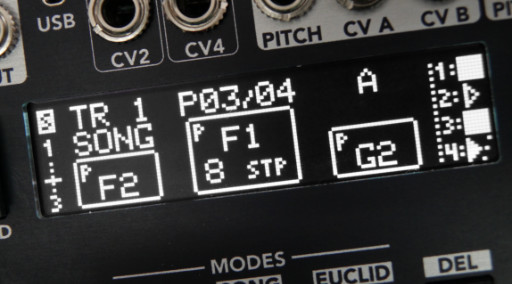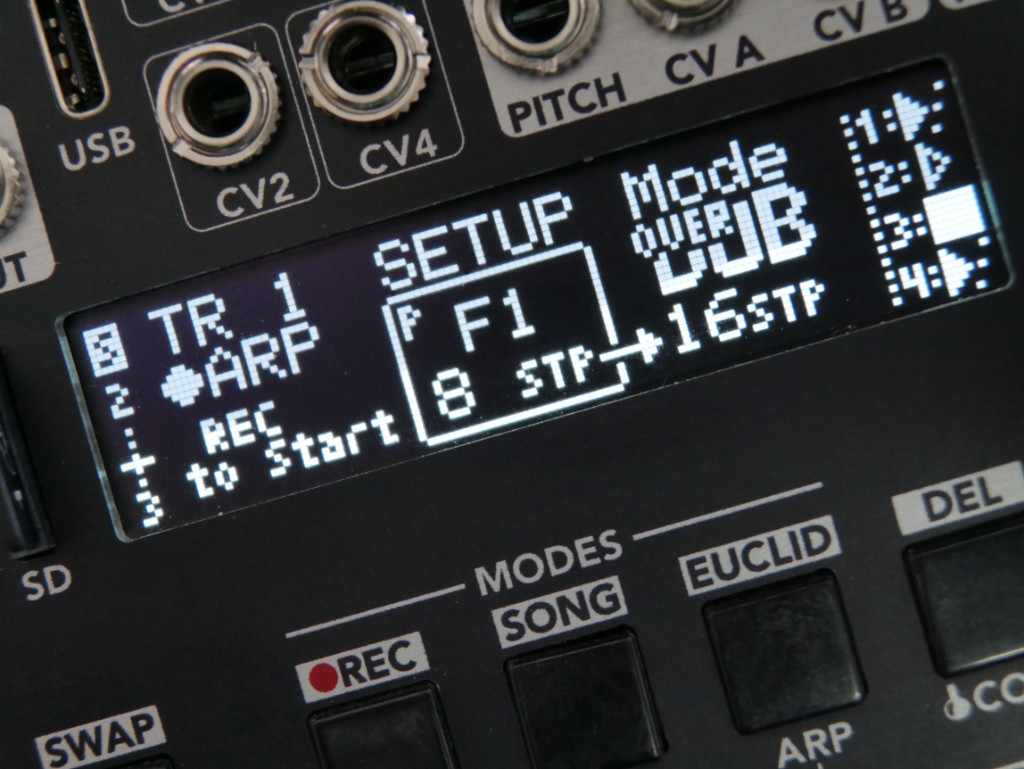Introduction
Brainstep is a sequencer, arpeggiator, envelope and modulation generator, live performance tool, sample player, clock distributor, MIDI interface and more.
The brain of a eurorack system.
Feature List
- Four independent tracks, each with the following features:
- Step sequencer with multiple patterns, song mode and probability per step.
Up to 24 patterns, 64 steps each.
Notes have four per-step modifiers to trigger accents, portamento or tie.
Each note can also be programmed to have one of 4 different gate lengths
Gates and modifiers can have various probability levels.
Seven directions including smart random modes allow even more sequence variation. - Feature rich arpeggiator with multiple octaves and seven direction modes including ‘order of key press’.
Can inherit the ‘chemistry’ of existing sequences, for expressive, evolving arpeggios
An Euclidian arpeggiator mode creates rhythmic arpeggios on the fly. - Optimized for live performance: Quickly create or modify patterns, switch between arp and sequencer, record, change patterns, …
– all while playing. - Live recording
Record keyboard presses or arpeggiator output into patterns. The overdub mode makes this a perfect live composing tool. - Envelope and modulation generator
Each track can output up to 4 envelopes and 2 LFOs for a total of 16 envs and 8 LFOs:- ADSR envelopes with loop mode
- Per step triggerable accent envelopes
- Free running or syncable LFO with multiple waveforms including random S/H and a wide frequency range
- Drum sample output
Each track can output drums samples:
– Select between different sample packs or create your own
– per step modifiers: Accent, double speed, half speed, reverse, gate length - CV control: The four bipolar CV-inputs can be freely mapped to many parameters of envelopes, LFOs, sequencer, arpeggiator, probabilities and more
- Multiple clocking options: Internal clock generator, MIDI clock, analog clock / trigger
Clock input and output: Can convert MIDI clock to analog clock, or be used as a central clock source. Clock divider per track.
Swing generator for every clock. - MIDI input and output: TRS-Midi and USB-C MIDI (Host or Device)
- Microtonal support: Load scales / tunings from the SD card
- Save / Load complete sets via SD card
Some features in more detail
Multi track architecture
Brainstep features four independent tracks with pitch CV and two additional CV outputs: A and B. Each of these tracks can be used to control a synthesizer voice and run a sequencer, arpeggiator or be played via a keyboard.
There are also two live recording modes.
CV-outs A and B can be freely configured to output gates, envelopes and LFOs.
Performance shortcuts allow the sequencers and arpeggiators to be started and stopped quickly, perfect for playing live.
Additionally a track can also be configured to output drum samples which can also be sequenced and arpeggiated.
The tracks are completely independent: You could run an arpeggiator on track 1, a sequencer on track 2, play drums via midi on track 3 and record a melody on track 4. All at the same time.
The sequencer
Brainstep features a step-based sequencer with up to 64 notes per pattern and 32 patterns total. Patterns can be created and modified any time and you can also modify one pattern, while another one is playing. A song mode can chain multiple patterns into a song – the song can also be created or modified at any time.
Several tools further ease sequencer programming: You can copy and paste patterns, and insert, delete, copy and paste single notes.
Note modifiers, lengths and probability
Each note can have additional parameters:
- There are four note modifiers per note: Trigger accent A, accent B, portamento and tie.
- Four gate lengths can be set for each note
- Probability: You can define the probability of the modifiers and gate in four levels: ON, High probability, Low probability and OFF. The levels of the probabilities can be set globally.
Live performing with the sequencer
There are multiple ways to switch patterns while the sequencer is playing: By just pressing one of the keyboard keys, Brainstep will switch to another pattern immediately – while staying in sync. Press PLAY and the pattern key and the new pattern will start when the currently playing one has finished. Finally, one can use quick song programming to chain multiple patterns on the fly and start the new song in sync.
This – combined with the patterns and song editors – allows easy live performances.
The arpeggiator
A powerful arpeggiator with seven directions and multiple octaves.
The directions include a mode which plays the notes in the order they are pressed. This allows you to program little sequences on the fly.
An especially unique feature is ‘chemistry patterns’: The arp can inherit the note chemistry (length, modifiers, probabilities, breaks) of patterns, which creates dynamic and rhythmic arp sequences.
The arpeggiator also has a euclidian mode (Euclidiator) that enables further rhytmic structures.
Recording
Brainstep features a live recorder with overdub functionality. You can record from a keyboard (internal keyboard, MIDI keyboard or CV/Gate) or from the arpeggiator.
Various modes are available: When setting up a recording, you can define if you want to create a new pattern, or overdub an existing one. You can also define the length of the pattern in advance.
The recording will start after a countdown and in sync with the clock. Even while recording you can switch to the pattern editor for tweaks and changes. Once recording is finished, you can seamlesly start playing the recorded or other pattern.
Arp recording
Arp recording allows you to record the output of the arpeggiator into a pattern.
While very handy by itself, this becomes especially fun when combined with overdubbing. Essentially turning the arpeggiator into a looper performance tool.
Envelopes
Each of a tracks A and B outputs has two different kinds of envelopes:
A full ADSR envelope and an accent envelope.
The accent envelope has attack and decay parameters, its amount can be set bipolarly. Accents can be triggered via note modifiers on a per-step basis.
The ADSR envelope has delay, attack, decay, susain and release. The release can be toggled between linear and exponential behavior. The envelopes can be put into looping mode and their amount controlled bipolarly.
LFOs
Each of the A and B outputs has a unique LFO, 8 LFOs total.
The LFOs have a large frequency range between 20s period and 1kHz and can run in free or synced mode. In synced mode, you can adjust the clock divider between 4 Beats and 1/32th, including triplets and odd time signatures.
Five wave forms are available, including a S/H style random LFO. Additionally, there are LFO delay and reset settings.
Drums and Samples
Each track can be configured to output samples on output B. The samples come as predefined packs with 12 samples and can be loaded from the SD card. You can also create your own sample packs. Sample output is monophonic and rather LO-FI – still a lot of fun.
Note modifiers also exist: For each sample you can define accent, double speed, half speed and reverse. These can be combined of course.
Each track can use its own sample pack.
CV modulation
The four CV inputs can be freely assigned to many of Brainstep’s parameters such as LFO, Envelopes, Glide time or swing amount.
The CV-inputs are bipolar (+-5V) and add to the existing parameter value rather than replacing them. Cv can therefore increase or decrease existing parameter settings.
An additional amount setting can attenuate the incoming CV.
Connectivity
Apart from the pitch, A and B outputs for each track, Brainstep also features:
- CV and gate inputs for external keyboards or CV sequencers. -3V … 7V
- Analog clock & start/stop inputs and outputs
- TRS MIDI inputs and outputs (Type A)
- MIDI USB-C – Can function as host or device, with autodetection.
- 4x general purpose CV-inputs
CLOCKS
Brainstep can be used with multiple clock sources:
- Analog clock with optional reset or start/stop signal
- MIDI clock
- DIN-sync
- Internal clock generator. Use Brainstep as the master clock source, BPM adjustable in 0.1 steps.
To any of these clocks, you can apply Swing/Shuffle with an adjustable amount. Swing amount is even controllable via CV, which means you can modulate rhythms with an LFO or from the sequencer.
Brainstep also outputs clocks: When the analog clock inputs are not used, they function as outputs. This allows you to convert a midi clock to an analog clock, or just output the internally generated clock. MIDI clock is also sent out optionally.
Sets, Saving and Loading
With the internal SD Card, Brainstep can save and load Sets as files.
Brainstep’s sets contain all sequencer data, arpegiator notes and states and modulation parameters.
Brainstep can also load sample packs and tunings/scales from the SD card.
Specs
Eurorack
Width: 22HP (111.5mm)
Height: 3U (128.5mm)
Depth: Panel to back: 13mm, 21mm including power connector
Aluminum front panel, 2mm
Weight: 217g
Power: +12V: 90mA, -12V: 20mA
Designed and made in Berlin, Germany
by Tubbutec

















